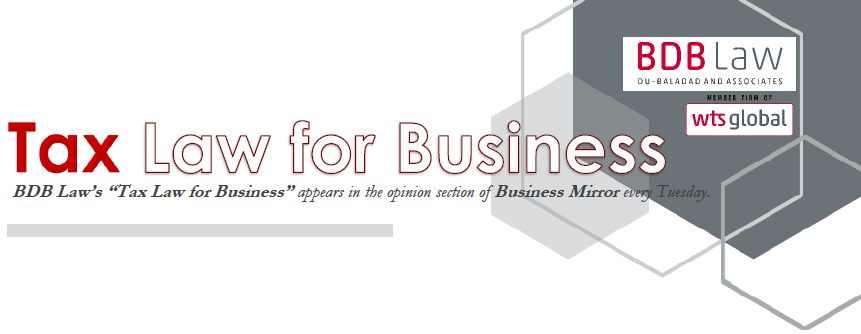
RETHINKING OUR TAX REFUND SYSTEM
By: Atty. Jomel N. Manaig
"Tax refunds do not have to be excessively difficult for both the taxpayer and the BIR. Certain practices can be adopted to enhance the entire tax refund system."
 Atty. Jomel N. Manaig +632 8403-2001 loc.380 |
The maturity of tax administration can be measured not only in the policies and procedures implemented to make tax collection efficient and to close tax loopholes, but also on how it effectively handles eligible tax refunds. After all, tax administration must be regarded in a holistic manner.
A tax refund system that fails to duly and timely grant claims discourages investments and production. Unrefunded excess taxes put unnecessary strain to taxpayers’ business cash flows and contributes to undue loss of possible earnings. On the other hand, tax authorities are likewise strained by mounting tax refund applications that are routinely filed.
 Although the BIR had made strides to make tax refunds easier for taxpayers, much can still be done.
Although the BIR had made strides to make tax refunds easier for taxpayers, much can still be done.
Tax refunds do not have to be excessively difficult for both the taxpayer and the BIR. Certain practices can be adopted to enhance the entire tax refund system.
For starters, the BIR may adopt a risk-based approach when it comes to the verification of applications for tax refund. Currently, all refund applicants are required to submit a wide variety of supporting documents ranging from a letter request to the related invoices and official receipts and even certifications from other government agencies. Such wholesale treatment of all applicants adds compliance burdens to taxpayers and increases the resources needed by the BIR to process the same.
By adopting a risk-based approach, tax refunds may be assessed as low-risk, medium-risk, or high-risk. Each risk category would have various degrees of scrutiny and verification. This would enable the BIR to focus on medium to high-risk applications while ensuring that low-risk applicants timely receive their refunds.
In line with the risk-based model, the BIR may likewise adopt an immediate refund system wherein low-risk applicants would receive their tax refund instantly subject to post-verification procedures. On the other hand, medium to high-risk applicants would undergo a more stringent verification process, or even a full audit, before the refund is granted. Anti-fraud measures employing historical and third-party data may also be used for these medium to high-risk applications.
Excess taxes should also not be regarded as idle resources of taxpayers. It represents funds which taxpayers could have used productively if it were in their hands. Since the excess taxes are kept by the BIR, interest equal to or even above the legal rate should accrue for pending and legitimate tax refunds if the refund is not granted within the prescribed period or otherwise unduly denied. This would ensure that the BIR would process claims for refund expeditiously and that taxpayers would be compensated for unrefunded excess taxes which they otherwise would have been entitled to.
But perhaps, the most impactful change I can recommend is to shift the existing mindset on the nature of certain tax refunds. For those familiar with tax refund applications, you may have already heard that “claims for refund partake the nature of exemption from taxation.” Consequently, tax refunds are strictly construed against the taxpayer. However, I would respectfully digress to this oversimplification of the nature of tax refund.
It should be noted that tax refunds come in all different shapes and sizes. It should not be looked through a one-size-fits-all lens. This is because some tax refunds are not really due to “tax exemptions” but rather are mere “excess payments” which should not be subjected to excessive administrative requirements.
The refund of excess creditable withholding taxes (CWT) is a perfect example. CWTs are withheld against the income payments of taxpayers because of the application of the withholding tax system. In effect, it is an advance collection by the BIR subject to the determination of the final income tax due. There is nothing remotely involving a tax exemption so why construe it strictly against the taxpayer? Why have the taxpayer-applicant jump through so many hoops just to refund something excessively collected from them in advance?
With the BIR’s drive to be a tax administrator in a modern world, it should not only enhance its ability to collect taxes. It should also boost its ability to address the tax refund concerns of taxpayers.
The author is a junior partner of Du-Baladad and Associates Law Offices (BDB Law), a member-firm of WTS Global.
The article is for general information only and is not intended, nor should be construed as a substitute for tax, legal or financial advice on any specific matter. Applicability of this article to any actual or particular tax or legal issue should be supported therefore by a professional study or advice. If you have any comments or questions concerning the article, you may e-mail the author at This email address is being protected from spambots. You need JavaScript enabled to view it. or call 8403-2001 local 380.




